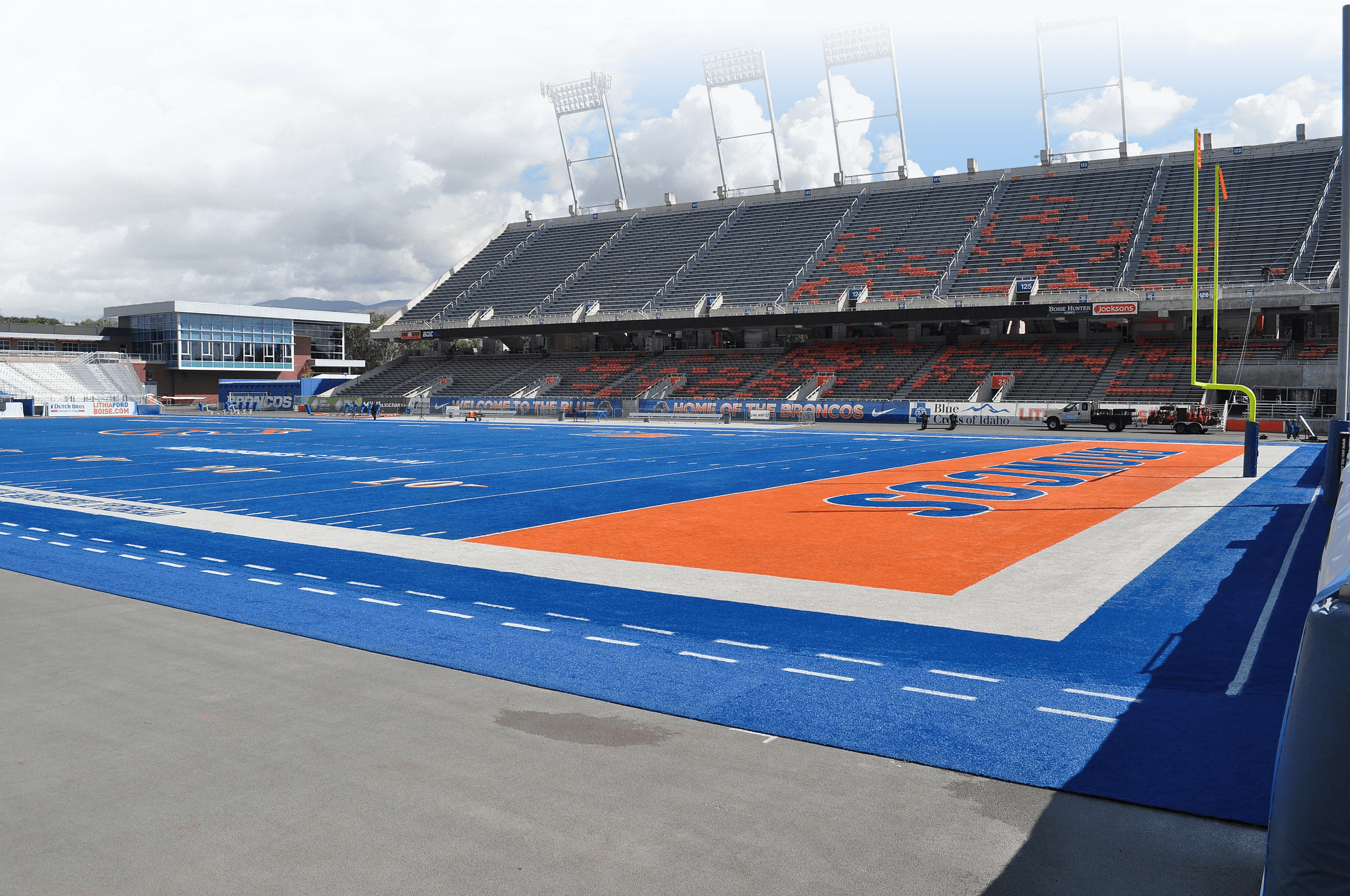BLUE ARTIFICIAL TURF
Albertsons Stadium is best known for its distinctive blue playing surface, which was the only non-green football playing surface among Division I FBS programs from Boise State's entry into what is now FBS in 1996 until Eastern Michigan installed a gray surface at Rynearson Stadium in 2014.
Chris Berman of ESPN has also called Boise's turf "The Blue Plastic Tundra", a joking reference to "the frozen tundra" of Lambeau Field in Green Bay, Wisconsin. Another nickname for the surface is "Smurf Turf." Players refer to it simply as "The Blue."
After sixteen seasons of playing on standard green AstroTurf, athletic director Gene Bleymaier came up with the idea to install the blue turf. He decided that, if BSU was going to spend $750,000 on a new surface, he didn't want to see BSU install yet another green field, and that a blue field might provide some national notoriety for the school, then a member of the Big Sky Conference. Bleymaier gained the support of BSU President John Keiser, and on September 13, 1986, Bronco Stadium introduced its unique playing surface to the world with a 74–0 victory over Division II Humboldt State. (BSU was 4–2 at home in 1986, but managed just one road victory and posted its first losing record in four decades, resulting in the resignation of fourth-year head coach Lyle Setencich.)
BSU replaced the first blue AstroTurf with the same in 1995, then with blue Astroplay (a grass-like synthetic surface that is more forgiving than traditional AstroTurf) in 2002. The AstroPlay field lasted just six seasons and was replaced in the summer of 2008 with blue FieldTurf surface. Due to complaints by fans that the reflection and glare off the field gave the new field a dull and uneven shade of blue, FieldTurf agreed to replace the field free of charge. The fifth blue turf was installed in the summer of 2010.
The unique blue turf has spawned several myths. The most prevalent is that the NCAA subsequently banned playing surface colors other than green, but allowed Albertsons Stadium's field to remain blue under a grandfather clause. In reality, the NCAA has never adopted such a rule. Any school may color its playing surface (or any part of the surface, such as the end zones) any color it wishes. Indeed, since 1986 other schools have non-green football fields including the University of New Haven (blue) and Eastern Washington University (red). On April 1, 2011, the University of Central Arkansas announced it would install a purple and grey striped field to Estes Stadium. In 2012, Lindenwood University in Belleville, Illinois, played their first football season, on a home field with alternating maroon and gray stripes. The blue turf at Boise State remained the only non-traditionally colored field used by a Division I FBS program until June 2014, when Eastern Michigan announced it would install a gray FieldTurf surface at Rynearson Stadium in time for the 2014 season.
Another myth is that, mistaking the blue field for a large body of water, birds have flown into the blue turf and to their deaths. Although Bronco head coach Chris Petersen claimed to have found a dead duck on the field in 2007, the origin of the duck on the field has never been confirmed.
BSU's blue turf has become such a highly visible icon for the Broncos that BSU obtained a U.S. trademark registration for a blue athletics field in November 2009. In 2010, this trademark was extended to any non-green field.
In 2011, the NFL banned any playing surface color other than green, naming the rule the "Boise Rule" in reference to the university, though this was more a reaction to sponsor influence as no team had ever proposed a different turf color for its field. Also in 2011, the Mountain West Conference banned Boise from wearing its all-blue uniforms during home conference games, after complaints from other Mountain West coaches that it was an unfair advantage. However, the uniform restriction was removed from the 2013 season forward, as part of the deal that kept Boise State in the MW after it had originally planned to leave the conference.
In October 2014, Boise State's blue field topped USA Today's Fan Index list of top 10 best fields in college football.

